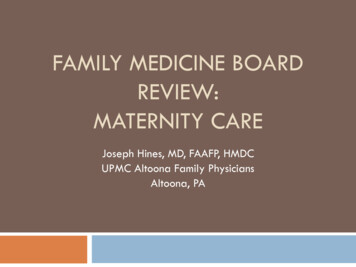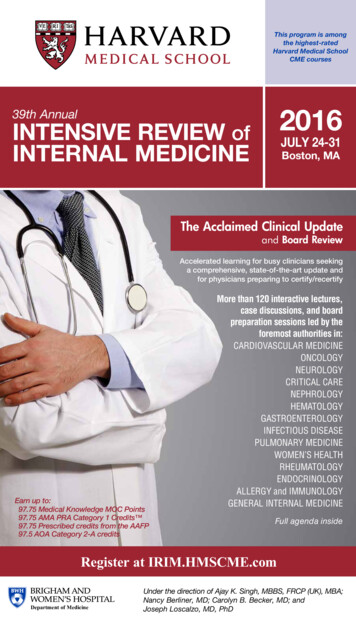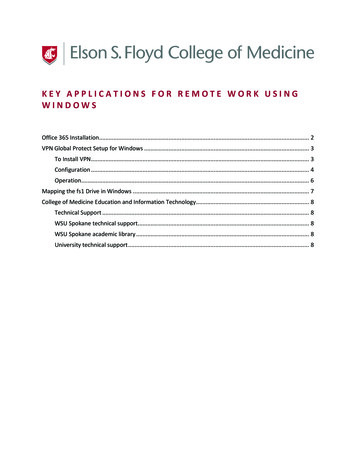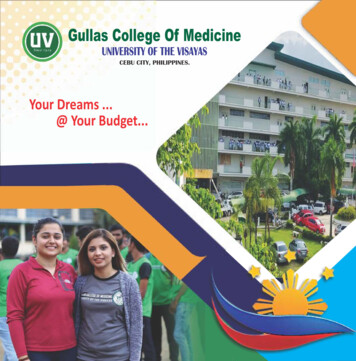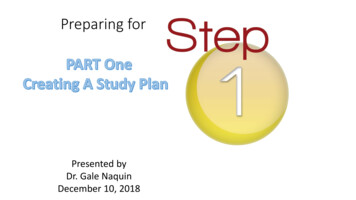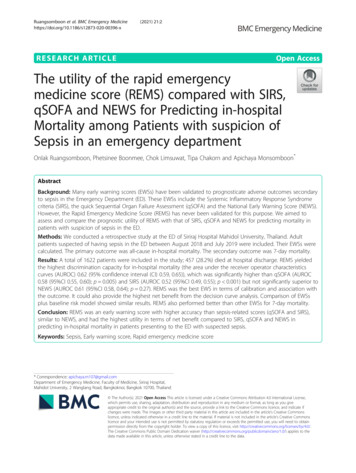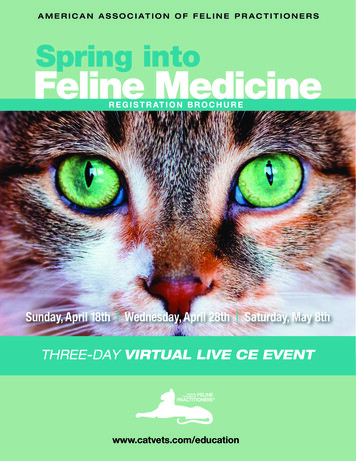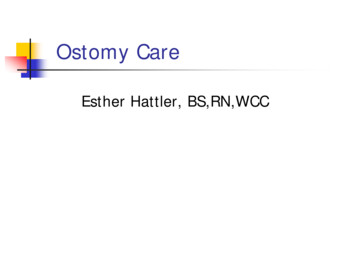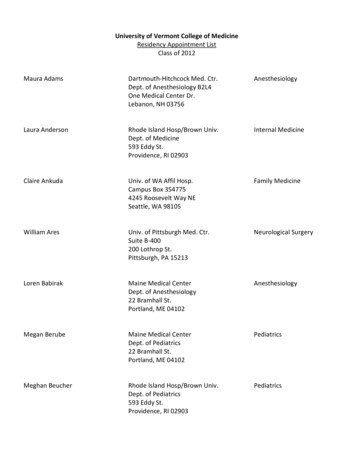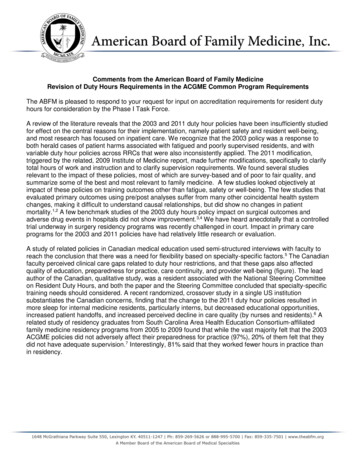
Transcription
MEDICINESTEM-Based
BOY SCOUTS OF AMERICAMERIT BADGE SERIESMEDICINE“Enhancing our youths’ competitive edge through merit badges”
Medicine1. Discuss with your counselor the influence that EIGHT of the f ollowing peoplehad on the history of health care:(a) Hippocrates(b) William Harvey(c) Antonie van Leewenhoek(d) Edward Jenner(e) Florence Nightingale(f) Louis Pasteur(g) Gregor Mendel(h) Joseph Lister(i) Robert Koch(j) Daniel Hale Williams(k) Wilhelm Conrad Roentgen(l) Marie and Pierre Curie(m) Walter Reed(n) Karl Landsteiner(o) Alexander Fleming(p) Charles Richard Drew(q) Helen Taussig(r) James Watson and Francis Crick(s) Jonas Salk2. Explain the Hippocratic Oath to your counselor, and compare the originalversion to a more modern one. Discuss to whom those subscribing to theoriginal version of the oath owe the greatest allegiance.3. Discuss the health-care provider–patient relationship with your counselor,and the importance of such a relationship in the delivery of quality care tothe patient. Describe the role of confidentiality in this relationship.4. Do the following:(a) Describe the roles the following people play in the delivery of health care:(1) Allopathic physician (M.D.) and osteopathic physician (D.O.)
(2) Chiropractor (D.C.)(3) Emergency medical technician(4) Licensed practical/vocational nurse(5) Medical assistant(6) Medical laboratory technologist(7) Nurse-midwife(8) Nurse practitioner(9) Occupational therapist(10) Optometrist(11) Pharmacist(12) Physical therapist(13) Physician’s assistant(14) Podiatrist(15) Psychologist(16) Radiologic technologist(17) Registered nurse(18) Respiratory therapist(b) Describe the educational and licensing requirements to practice healthcare in your state for FIVE of the professions in requirement 4a. (Not allprofessions may exist in your state.)5. (a) Tell what is meant by the term “primary care” with regard to amedical specialty.(b) Briefly describe the types of work done by physicians in thefollowing specialties:(1) Internal medicine*(2) Family practice*(3) Obstetrics/gynecology*(4) Pediatrics*(5) Psychiatry(6) Surgery(c) Describe the additional educational requirements for these specialties.6. (a) Briefly describe the types of work performed by physicians in FIVE of thefollowing specialties or subspecialties:(1) Allergy/immunology(2) Anesthesiology(3) Cardiology(4) Colorectal surgery(5) Critical care medicine (intensive care medicine)(6) Dermatology(7) Emergency medicine(8) Endocrinology*“Primary care” specialties
ogyGeriatric medicineHematology/oncologyHospitalistInfectious diseaseNephrologyNeurosurgeryNeurologyNuclear medicineOphthalmologyOrthopedic surgeryOtolaryngology/head and neck surgeryPathologyPhysical medicine and rehabilitationPlastic, reconstructive, and maxillofacial surgeryPreventive ardiothoracic sur geryUrologyVascular surgery(b) Describe the additional educational requirements for the FIVE specialtiesor subspecialties you chose in 6a.7. (a) Visit a physician’s office*, preferably one who delivers “primary care.”(This may be that of your counselor.) Discuss the components of a medicalhistory and physical examination (an official BSA health form may be used toguide this discussion), and become familiar with the instruments used.(b) Describe the characteristics of a good diagnostic test to screen for disease(e.g., routine blood pressure measurement). Explain briefly why diagnostictests are not “perfect.”(c) Show how to take a blood pressure and a pulse reading.8. Do the following:(a) Discuss the roles medical societies, employers, the insurance industry, ractice of medicine in theand the government play in influencing the pUnited States.(b) Briefly tell how your state monitors the quality of health care within itsborders, and how it provides care to those who do not have health insurance.9. Compare and discuss with your counselor at least two types of health caredelivery systems used throughout the world.* If this cannot be arranged, demonstrate to your counselor that you understand the components of amedical history and physical, and discuss the instruments involved.
10. Serve as a volunteer at a health-related event or facility in your community(e.g., blood drive, “health fair,” blood pressure screening, etc.) approved byyour counselor.
Resources.ResourcesScouting LiteratureAnimal Science, Dentistry, First Aid,Personal Fitness, Public Health,Veterinary Medicine, and WildernessSurvival merit badge pamphletsVisit the Boy Scouts of America’sofficial retail website athttp://www.scoutstuff.org for acomplete listing of all merit badgepamphlets and other helpfulScouting materials and supplies.Adler, Robert E. Medical Firsts: FromHippocrates to the Human Genome.John Wiley and Sons, 2004.Fridell, Ron. Decoding Life: Unravelingthe Mysteries of the Genome.Lerner Publications, 2005.Karlen, Arno. Man and Microbes:Disease and Plagues in Historyand Modern Times. TouchstoneBooks, 1996.Kent, Deborah. Snake Pits, TalkingCures, and Magic Bullets: A Historyof Mental Illness. Twenty-FirstCentury Books, 2003.Loudon, Irvine. Western Medicine:An Illustrated History. OxfordUniversity Press, 1997.Alter, Judy. Surgery (21st Century SkillsInnovation Library). Cherry LakePublishing, 2008.Ludmerer, Kenneth M. Time to Heal:American Medical Education Fromthe Turn of the Century to the Eraof Managed Care. Oxford UniversityPress, 2005.Cowen, David L., and William H.Helfand. Pharmacy: An IllustratedHistory. Harry N. Abrams, 1990.Lyons, Albert S., and R. Joseph Petrucelli.Medicine: An Illustrated History, rev.ed. Harry N. Abrams, 1997.Dawson, Ian. Greek and Roman Medicine.Enchanted Lion Books, 2005.Manjo, Guido. The Healing Hand: Manand Wound in the Ancient World.Harvard University Press, 1991.———. Medicine During the Renaissance.Enchanted Lion Books, 2005.———. Medicine in the Middle Ages.Enchanted Lion Books, 2005.94 MEDICINENuland, Sherwin B. Doctors: TheIllustrated History of MedicalPioneers. Black Dog &Leventhal, 2008.
.ResourcesNunn, John F. Ancient EgyptianMedicine. University of OklahomaPress, 2002.Risse, Guenter B. Mending Bodies,Saving Souls: A History of Hospitals.Oxford University Press, 1999.Rosenberg, Charles E. The Care ofStrangers: The Rise of America’sHospital System. Johns HopkinsUniversity Press, 1995.———. Explaining Epidemics: And OtherStudies in the History of Medicine.Cambridge University Press, 1992.American Nurses AssociationWebsite: http://www.ana.orgAmerican Society ofRadiologic TechnologistsToll-free telephone: enters for Disease Controland PreventionToll-free telephone: 800-232-4636Website: http://www.cdc.govfamilydoctor.orgWebsite: http://www.familydoctor.orgSacks, Terence J. Careers in Medicine.McGraw-Hill, 2006.HealthCare.govWebsite: http://www.healthcare.govStraus, Eugene, and Alex Straus.Medical Marvels: The 100 GreatestAdvances in Medicine. PrometheusBooks, 2006.healthfinder.govWebsite: http://www.healthfinder.govTilney, Nicholas L. Invasion of theBody: Revolutions in Surgery.Harvard University Press, 2011.MedlinePlus Website: http://www.medlineplus.govTownsend, John. Bedpans, Blood, andBandages: A History of Hospitals.Raintree, 2007.———. Pills, Powders, and Potions:A History of Medication.Raintree, 2007.———. Pox, Pus, and Plague:A History of Disease and Infection.Raintree, 2006.———. Scalpels, Stitches, and Scars:A History of Surgery. Raintree, 2006.Organizations andGovernment AgenciesAmerican Medical AssociationToll-free telephone: 800-621-8335Website: http://www.ama-assn.orgMayo ClinicWebsite: http://www.mayoclinic.comNational Health Information CenterU.S. Department of Health andHuman ServicesReferral SpecialistP.O. Box 1133Washington, DC 20013-1133Telephone: 240-453-8280Website: http://www.health.gov/nhicNational Institutes of HealthTelephone: 301-496-4000Website: http://www.nih.govSuperintendent of DocumentsU.S. Government Printing OfficeWebsite: http://www.gpo.govAcknowledgmentsThe Boy Scouts of America thanksthe following individuals for theircontributions to this pamphlet: CharlesMEDICINE 95
94 MEDICINE Resources. Resources Scouting Literature Animal Science, Dentistry, First Aid, Personal Fitness, Public Health, Veterinary Medicine, and Wilderness Survival merit b

